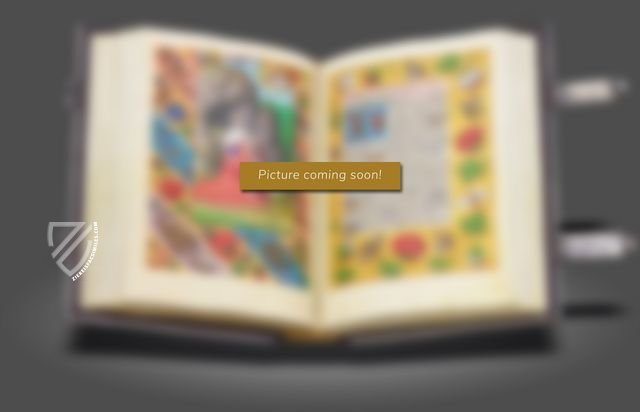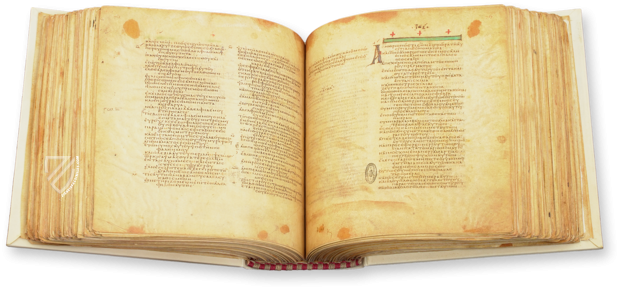Rerum Medicarum Novae Hispaniae Thesaurus
(1,000€ - 3,000€)
This vast 17th century printed tome is an incredible compendium concerning the botany, zoology, and minerology of the New World. Originally commissioned in 1570 by King Philip II of Spain (1527–98), the work would take 80 years to complete and required the collaboration physicians, scientists, draughtsman, and printers. Finally published in 1651, the work is primarily concerned with the medicinal applications of previously unknown plants from the New World. This particular copy is also known as the Esemplare Cesiano because of its rich handwritten annotations by Federico Cesi (1585‒1630), the Italian naturalist and founder of the Accademia dei Lincei in Rome.
Rerum Medicarum Novae Hispaniae Thesaurus
A scientific work 80 years in the making: after being first commissioned in 1570 by King Philip II of Spain (1527-98), the Novae Hispaniae thesaurus, seu, Plantarum animalium mineralium Mexicanorum historia or “Inventory of medical items from New Spain, or “History of Mexican plants, animals and minerals” was finally published in 1651. It consists of an exhaustive study of the natural environment of the New World with a special emphasis on the medical applications of its as-yet-unknown plants. Commonly known as the Tesoro Messicano or Mexican treasure, this copy is also known as the Esemplare Cesiano for its rich handwritten annotations by Federico Cesi (1585‒1630), the Italian naturalist and founder of the Accademia dei Lincei in Rome.
An Epic Labor
The project began when the Philip II appointed his court physician, Francisco Hernández de Toledo (1514-1587), to be chief physician of the Indies. Philip ordered Hernández to travel to Mexico, but when he returned seven years later, the huge collection of unintelligible names together with drawings depicting unknown plants and animals did not receive the King’s approval. Hernández was replaced by Leonardo Recchi, who organized the text into a form that that was more in line with the King’s original desire for a list of plants with medical uses. In 1610, Recchi’s manuscript found its way into the hands of Cesi, who took on the task of completing the work and ensuring that it was printed. Cesi commissioned commentary and exegesis by Johannes Faber, Fabio Colonna, and Joannes Terentius, and he had Francesco Stelluti compile the indexes. The volume carries four printing privileges dating from 1623‒27: Privilegium Summi Pontificis (by Pope Urban VIII), Privilegium Imperatoris (by Holy Roman Emperor Ferdinand II), Privilegium Regis Galliae (by King Louis XIII of France), and Privilegium Magni Ducis Etruriae (by Ferdinando II, duke of Tuscany), plus a dedication to Philip IV dated 1650 and the imprimatur of 1651. The title page, engraved by Johann Friedrich Greuter, has the incorrect date of 1649.
The Convoluted Printing Process
Publishing the volume was a disordered process of assembling various parts that were first printed separately at different times, but this was nonetheless accomplished by Vitale Mascardi(ca. 1634-49 fl.), a printer and architect in Rome. The first part of the grand encyclopedia consists of ten books: the first book, Prolegomena (Foreword), explains the methodology followed by Recchi in processing the text of Hernández. Books two through eight contain descriptions of plants; the ninth book has descriptions of animals; while the tenth deals with minerals. The second part (pp. 465‒840) is a detailed description of the animals of Mexico by Johannes Faber (1574-1629). The third part (pp. 841‒99) contains Annotationes et Additiones (Notes and addenda) by Fabio Colonna (1567-1640).
Cesi’s Rich Annotations
The work ends with 20 tables, identified as Tabulae Phytosophicae (botanical tables) by Cesi and even though he did not finish the compilation of Tabulae Phytosophicae, the completed tables appear in the present copy. Cesi’s annotations are either brief cross-referencing notes, placed under the titles and very often close to the figures of flowers and plants, or complex marginal notes on the outside edge of the pages. His notes identify plants and, where necessary, propose new names. The work is a monumental 17th century compendium of the botany, zoology, and mineralogy of the New World, the result of teamwork over many decades between scientists and travelers.
Codicology
- Alternative Titles
- Tesoro Messicano
Mexican Treasure
Esemplare Cesiano - Size / Format
- 952 pages / 33.1 × 22.3 cm
- Origin
- Spain
- Date
- 16th – 17th century
- Epochs
- Style
- Content
- Prolegomena (Foreword); Descriptions of Mexican animals; Annotationes et Additiones (Notes and addenda); Tabulae Phytosophicae (Botanical tables).
- Patron
- King Philip II of Spain
- Artist / School
- Francisco Hernández de Toledo
#1 Rerum Medicarum Novae Hispaniae Thesaurus
Language: Italian
(1,000€ - 3,000€)
- Treatises / Secular Books
- Apocalypses / Beatus
- Astronomy / Astrology
- Bestiaries
- Bibles / Gospels
- Chronicles / History / Law
- Geography / Maps
- Saints' Lives
- Islam / Oriental
- Judaism / Hebrew
- Single Leaf Collections
- Leonardo da Vinci
- Literature / Poetry
- Liturgical Manuscripts
- Medicine / Botany / Alchemy
- Music
- Mythology / Prophecies
- Psalters
- Other Religious Books
- Games / Hunting
- Private Devotion Books
- Other Genres
- Afghanistan
- Armenia
- Austria
- Belgium
- Colombia
- Croatia
- Cyprus
- Czech Republic
- Denmark
- Egypt
- Ethiopia
- France
- Germany
- Greece
- Hungary
- India
- Iran
- Iraq
- Israel
- Italy
- Japan
- Lebanon
- Luxembourg
- Mexico
- Morocco
- Netherlands
- Palestine
- Peru
- Poland
- Portugal
- Russia
- Serbia
- Spain
- Sri Lanka
- Sweden
- Switzerland
- Syria
- Turkey
- Ukraine
- United Kingdom
- United States
- Uzbekistan
- Aboca Museum
- Ajuntament de Valencia
- Akademie Verlag
- Akademische Druck- u. Verlagsanstalt (ADEVA)
- Aldo Ausilio Editore - Bottega d’Erasmo
- Alecto Historical Editions
- Alkuin Verlag
- Almqvist & Wiksell
- Amilcare Pizzi
- Andreas & Andreas Verlagsbuchhandlung
- Archa 90
- Archiv Verlag
- Archivi Edizioni
- Arnold Verlag
- ARS
- Ars Magna
- ArtCodex
- AyN Ediciones
- Azimuth Editions
- Badenia Verlag
- Bärenreiter-Verlag
- Belser Verlag
- Belser Verlag / WK Wertkontor
- Benziger Verlag
- Bernardinum Wydawnictwo
- BiblioGemma
- Biblioteca Apostolica Vaticana (Vaticanstadt, Vaticanstadt)
- Bibliotheca Palatina Faksimile Verlag
- Bibliotheca Rara
- Boydell & Brewer
- Bramante Edizioni
- Bredius Genootschap
- Brepols Publishers
- British Library
- C. Weckesser
- Caixa Catalunya
- Canesi
- CAPSA, Ars Scriptoria
- Caratzas Brothers, Publishers
- Carus Verlag
- Casamassima Libri
- Chavane Verlag
- Christian Brandstätter Verlag
- Circulo Cientifico
- Club Bibliófilo Versol
- Club du Livre
- CM Editores
- Collegium Graphicum
- Collezione Apocrifa Da Vinci
- Comissão Nacional para as Comemorações dos Descobrimentos Portugueses
- Coron Verlag
- Corvina
- CTHS
- D. S. Brewer
- Damon
- De Agostini/UTET
- De Nederlandsche Boekhandel
- De Schutter
- Deuschle & Stemmle
- Deutscher Verlag für Kunstwissenschaft
- DIAMM
- Droz
- E. Schreiber Graphische Kunstanstalten
- Ediciones Boreal
- Ediciones Grial
- Ediclube
- Edições Inapa
- Edilan
- Editalia
- Edition Deuschle
- Edition Georg Popp
- Edition Leipzig
- Edition Libri Illustri
- Editiones Reales Sitios S. L.
- Éditions de l'Oiseau Lyre
- Editions Medicina Rara
- Editorial Casariego
- Editorial Mintzoa
- Editrice Antenore
- Editrice Velar
- Edizioni Edison
- Egeria, S.L.
- Eikon Editores
- Electa
- Emery Walker Limited
- Enciclopèdia Catalana
- Eos-Verlag
- Ephesus Publishing
- Ernst Battenberg
- Eugrammia Press
- Extraordinary Editions
- Fackelverlag
- Facsimila Art & Edition
- Facsimile Editions Ltd.
- Facsimilia Art & Edition Ebert KG
- Faksimile Verlag
- Feuermann Verlag
- Folger Shakespeare Library
- Franco Cosimo Panini Editore
- Friedrich Wittig Verlag
- Fundación Hullera Vasco-Leonesa
- G. Braziller
- Gabriele Mazzotta Editore
- Gebr. Mann Verlag
- Gesellschaft für graphische Industrie
- Getty Research Institute
- Giovanni Domenico de Rossi
- Giunti Editore
- Graffiti
- Grafica European Center of Fine Arts
- Guido Pressler
- Guillermo Blazquez
- Gustav Kiepenheuer
- H. N. Abrams
- Harrassowitz
- Helikon
- Hendrickson Publishers
- Henning Oppermann
- Herder Verlag
- Hes & De Graaf Publishers
- Hoepli
- Holbein-Verlag
- Hortus Deliciarum
- Houghton Library
- Hugo Schmidt Verlag
- Idion Verlag
- Il Bulino, edizioni d'arte
- ILte
- Imago
- Insel Verlag
- Instituto Nacional de Antropología e Historia
- Istituto dell'Enciclopedia Italiana - Treccani
- Istituto Ellenico di Studi Bizantini e Postbizantini
- Istituto Geografico De Agostini
- Istituto Poligrafico e Zecca dello Stato
- Italarte Art Establishments
- J. Thorbecke
- Jan Thorbecke Verlag
- Johnson Reprint Corporation
- Josef Stocker
- Josef Stocker-Schmid
- Jugoslavija
- Karl W. Hiersemann
- Kasper Straube
- Kaydeda Ediciones
- Kindler Verlag / Coron Verlag
- Kodansha International Ltd.
- Konrad Kölbl Verlag
- Kurt Wolff Verlag
- La Liberia dello Stato
- La Linea Editrice
- La Meta Editore
- Lambert Schneider
- Landeskreditbank Baden-Württemberg
- Leo S. Olschki
- Les Incunables
- Library of Congress
- Libreria Musicale Italiana
- Lichtdruck
- Lito Immagine Editore
- Lumen Artis
- Lund Humphries
- M. Moleiro Editor
- Maison des Sciences de l'homme et de la société de Poitiers
- Manuscriptum
- Martinus Nijhoff
- Maruzen-Yushodo Co. Ltd.
- MASA
- McGraw-Hill
- Militos
- Millennium Liber
- Müller & Schindler
- Nahar and Steimatzky
- National Library of Wales
- Neri Pozza
- Nova Charta
- Oceanum Verlag
- Odeon
- Orbis Mediaevalis
- Orbis Pictus
- Österreichische Staatsdruckerei
- Oxford University Press
- Pageant Books
- Parzellers Buchverlag
- Patrimonio Ediciones
- Pattloch Verlag
- PIAF
- Pieper Verlag
- Plon-Nourrit et cie
- Prestel Verlag
- Princeton University Press
- Prisma Verlag
- Priuli & Verlucca, editori
- Pro Sport Verlag
- Propyläen Verlag
- Pytheas Books
- Quaternio Verlag Luzern
- Reales Sitios
- Recht-Verlag
- Reichert Verlag
- Reichsdruckerei
- Riehn & Reusch
- Roberto Vattori Editore
- Rosenkilde and Bagger
- Roxburghe Club
- Salerno Editrice
- Sarajevo Svjetlost
- Schöck ArtPrint Kft.
- Scolar Press
- Scrinium
- Scripta Maneant
- Scriptorium
- Siloé, arte y bibliofilia
- SISMEL - Edizioni del Galluzzo
- Sociedad Mexicana de Antropología
- Société des Bibliophiles & Iconophiles de Belgique
- Soncin Publishing
- Sorli Ediciones
- Stainer and Bell
- Studer
- Styria Verlag
- Sumptibus Pragopress
- Szegedi Tudomànyegyetem
- Taberna Libraria
- Tarshish Books
- Taschen
- Tempus Libri
- Testimonio Compañía Editorial
- Thames and Hudson
- The Clear Vue Publishing Partnership Limited
- The Facsimile Codex
- The Folio Society
- The Marquess of Normanby
- The Richard III and Yorkist History Trust
- Tip.Le.Co
- TouchArt
- TREC Publishing House
- TRI Publishing Co.
- Trident Editore
- Typis Regiae Officinae Polygraphicae
- Union Verlag Berlin
- Universidad de Granada
- University of California Press
- University of Chicago Press
- Urs Graf
- Vallecchi
- Van Wijnen
- VCH, Acta Humaniora
- VDI Verlag
- VEB Deutscher Verlag für Musik
- Verlag Anton Pustet / Andreas Verlag
- Verlag Bibliophile Drucke Josef Stocker
- Verlag der Münchner Drucke
- Verlag für Regionalgeschichte
- Verlag Styria
- Vicent Garcia Editores
- W. Turnowsky
- Waanders Printers
- Wiener Mechitharisten-Congregation (Wien, Österreich)
- Wissenschaftliche Buchgesellschaft
- Wydawnictwo Dolnoslaskie
- Xuntanza Editorial
- Zakład Narodowy
- Zollikofer AG





